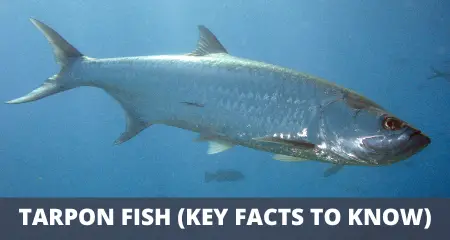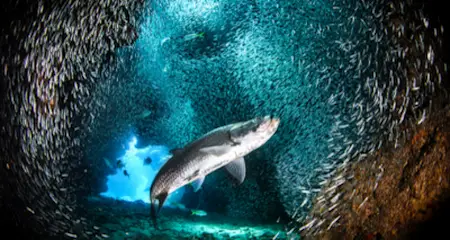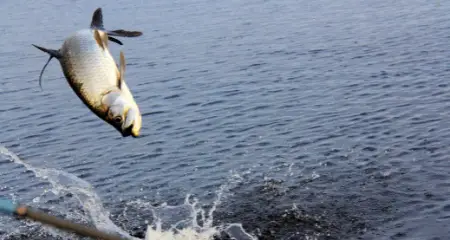11 Tarpon Facts You Need To Know
UPDATED 03 NOVEMBER 2023
by Robert Ceran
Tarpon are viewed as the ultimate game fish by many anglers around the world.
Also known as the “silver king”, tarpon can grow to enormous sizes and they put up an incredible fight that can last for hours after being hooked.
But many people don’t know a lot about this giant silvery fish that is capable of amazing aerial acrobatics at the end of a fishing line.

In this article we’ll cover the key facts about tarpon biology, and will also discuss where you can catch them, and whether they are good to eat.
Key tarpon facts
Here is a quick summary of the most important tarpon facts:
- Scientific name: Megalops atlanticus (Atlantic & Caribbean), Megalops cyprinoides (Pacific & Indian ocean).
- Tarpon size: Tarpon can grow up to 8 feet long, and weigh up to 350 pounds.
- Lifespan: Tarpon can live more than 50 years, with a maximum age of 63 years recorded in captivity.
- Range: The Atlantic tarpon is found in the western Atlantic from Cape Hatteras in North Carolina to southern Brazil, as well as in the eastern Atlantic from Senegal to Angola. It is also common throughout the Caribbean and the Gulf of Mexico.
- Tarpon habitat: Tarpon are usually found in shallow coastal waters from 2 to 100 feet depth. They are also found in brackish water and lagoons, as well as freshwater rivers and canals.
Now let’s dive into the details and cover some additional tarpon facts that are good to know.
How big do tarpon get?
Tarpon can grow to enormous sizes, reaching over 8 feet in length and 350 pounds in weight. However, the average tarpon size is considerably smaller than this, and usually ranges from 20 to 80 pounds.
Tarpon are slow growing fish that take 6-7 years in order to reach sexual maturity. A 100 lb tarpon is usually between 13 and 16 years old. Similar to other fish species, female tarpon are generally larger than males.
How big is the world record tarpon caught?
The all-tackle world record tarpon is 286 pounds 9 ounces, and was caught by Max Domecq in Guinea-Bissau (Africa) in 2003. There are several additional world records of tarpon caught on different types of fishing tackle, most of which are from Florida.
The fly tackle world record tarpon is 202 pounds 8 ounces, and was caught by James Holland Jr. in Chassahowitzka, Florida in 2001. The Florida state record tarpon is 243 pounds, and was caught by Gus Bell in Key West, Florida in 1975.
In addition to the tarpon records that have been officially verified, it’s likely that even bigger tarpon have been caught by sport fishermen, but since most tarpon anglers practice catch and release, many of these fish have not been not officially recorded.
Where do tarpon live?
Tarpon are primarily marine fish that live in shallow nearshore areas along the coast. They are most commonly found in bays, coral reefs, lagoons, estuaries and salt marshes. Atlantic tarpon can live both in polluted and clean water, and have a strong preference for warm temperatures.
Can tarpon live in freshwater?
Yes, tarpon can live in freshwater, and often spend extended periods of their life cycle in fresh water, as well as brackish water in river mouths. Juvenile tarpon migrate from the ocean into freshwater rivers, where they spend several years before returning to the ocean.
Larger fishes and adult tarpon are usually found in the ocean, where they live in shallow coastal waters. However, in some locations (such as Lake Nicaragua), adult tarpon can remain in freshwater during their whole life cycle.
What do tarpon eat?
Adult tarpon are strictly carnivorous and primarily feed on other fish species, as well as shrimp and crabs.
The main fish prey of tarpon depends on the species that are most common in their environment. In many locations their number one prey are mullet, followed by silversides, sardines, marine catfish, needlefish, and pinfish.

Tarpon also eat dead fish, which they pick up from the bottom or floating in the water.
Tarpon are extremely fast underwater hunters, capable of explosive acceleration that catapults them into the midst of a baitfish school. When a tarpon is inside a bait fish school, it opens its large cavernous mouth to create a suction effect that pulls nearby prey into it.
Tarpon have very small teeth, and hence swallow their prey whole.
Why do tarpon roll?
Tarpon roll at the surface of the water in order to gulp air, which they inhale in order to absorb oxygen through their swim bladder.
While the main respiratory organs of tarpon are their gills, they can also absorb oxygen through their modified swim bladder, and they have a direct connection from their throat to the swim bladder for this purpose.
The video below shows footage of a tarpon school rolling at the surface:
By gulping air while rolling at the surface, tarpon can inhale atmospheric oxygen and thus survive in waters that have very low oxygen levels. This is a key reason why tarpon are so hardy and can live in stagnant waters that are very low in oxygen.
Tarpon rolling behavior is used by fishing guides on charter boats to locate schools of tarpon. These boats usually have a lookout that scans the horizon for the tell tale signs of a tarpon school rolling at the surface.
How long do tarpon live?
Tarpon can live for over 50 years, with the oldest known tarpon reaching 63 years of age in captivity at the G. Shedd Aquarium in Chicago. Females typically live longer than males, usually reaching around 50 years of age, while males only live to be around 30 years old.
Where do tarpon spawn?
The spawning biology of tarpon is the least understood part of their life history, but current evidence suggests that tarpon spawn in areas more than 100 miles offshore. They migrate from the coast to their offshore spawning grounds in deeper water during the summer months (May to July).
During the spawn, which primarily occurs during full moons, fully grown females can lay up to 12 million eggs. After hatching, larval tarpon are carried by the ocean tides to shallow inshore areas, where they spend the first years of their life.
Are tarpon good to eat?
While it’s possible to eat tarpon, most people don’t enjoy eating tarpon because they are very bony fishes, and their meat has a strong flavor that is not very agreeable to most.
As a result, tarpon is rarely used as a food fish, and most tarpon anglers instead practice catch and release fishing.
The fact that tarpon doesn’t taste very good does come with one advantage: because of its poor taste, tarpon is of no interest to commercial fishermen, and this has been great for tarpon conservation.
Are tarpon dangerous to humans?
Tarpon do not attack humans in the wild, and are not dangerous to swimmers or divers. However, tarpon can be dangerous to recreational anglers when trying to land a tarpon after hooking it.
This is because tarpon are extremely strong, and a big tarpon thrashing around the deck of a boat is not only capable of destroying equipment, but can also injure people.
In order to avoid this, it is important to fight a tarpon long enough to tire it out completely, before attempting to bring a tarpon to the boat and land it.
Another option is to remove the hook from the mouth of the tarpon while it’s still in the water, without ever lifting it onto the boat.
Many tarpon anglers choose this latter option, not only for the sake of safety, but also in order to release the fish unharmed, and thus improve its chances of surviving afterwards.
Can tarpon bite you?
A tarpon can bite you while you’re trying to remove the hook from its mouth. So if you’re an angler, the best way to avoid getting bit by a tarpon is to use long nose pliers to remove the hook from its mouth.
You can also get bit by a tarpon if you’re trying to feed them in one of the tarpon feeding areas, the most famous of which is at Robbie’s Marina Dock in Islamorada, Florida.
However, since tarpon teeth are very small and have the consistency of sandpaper, getting bit by a tarpon is not really dangerous (though it can be abrasive and painful).
Tarpon fishing
Due to their huge size and sheer will to fight, tarpon are one of the most highly sought after game fish in the world, which explains why they are also called the ‘silver king’ by many anglers.
A key reason why tarpon are so popular as sport fish is because they perform spectacular aerial acrobatics after being hooked, and can leap up to ten feet out of the water.

The best way to catch tarpon is to hire a charter boat specialized in fishing for tarpon, since a good captain will save you a lot of time and effort required to find schools of tarpon, as well as providing you with the right equipment and tactics for success.
Finally, since tarpon live in shallow coastal waters, this also makes them an ideal species to target with saltwater fly fishing, and tarpon fly fishing has steadily gained in popularity over the years.
Where is the best place to catch tarpon?
The best tarpon fishing in North America is found in South Florida and along Florida’s west coast, with Boca Grande as one of the most popular tarpon fishing spots overall.
Indeed, during the peak tarpon season in May and June, people from all over the world come to Boca Grande to catch tarpon.
Other good places to catch tarpon are Tampa Bay, the Florida Keys, Florida Bay, as well as Biscayne Bay near Miami, where giant tarpon are caught by anglers every year.
What animals eat tarpon?
Juvenile tarpon are eaten by many other animals (including other tarpon), and are very vulnerable during their larval stages. But when they reach adulthood, only few predators remain that are capable of hunting tarpon.
The main predators of adult tarpon are bull shark, tiger shark and hammerhead shark, and more rarely also alligators and porpoises.
